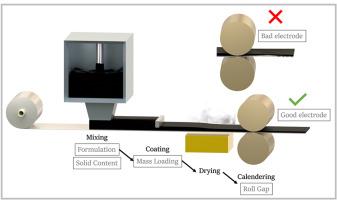Exploring processability limitations of commercial hard carbon for negative electrodes of Na-ion batteries
IF 7.9
2区 工程技术
Q1 CHEMISTRY, PHYSICAL
引用次数: 0
Abstract
Optimizing electrode manufacturing processes for sodium-ion batteries (SIBs) is crucial for enhancing their performance and commercial viability. This study systematically investigates the influence of critical electrode fabrication parameters, including solid content, mass loading, and calendering, on commercial hard carbon (HC) electrode properties. Slurries prepared with 35 % and 40 % solid content (SC) demonstrated distinct rheological behaviours, directly affecting electrode mechanical stability and processability. The slurry with SC-35 % provided a better balance between manageable viscosity and robust mechanical stability upon drying, whereas SC-40 % slurry exhibited higher viscosity, particle agglomeration, and poorer electrode mechanical integrity. Calendering was studied at compression degrees of 10 %, 20 %, and 30 %, revealing limited effectiveness in reducing porosity due to the intrinsic mechanical properties of HC, whereas, higher compression degrees led to structural damage. Electrochemical studies conducted in half-cells (HC vs. Na) and full-cells (HC vs. Na3V2(PO4)3) clearly indicated better electrochemical performance at moderate calendering degrees (10–20 %), effectively balancing mechanical integrity and electrical conductivity. This comprehensive study results in a useful experimental database in academic literature, underscoring the importance of precise control over slurry formulation and calendering parameters to achieve structurally robust electrodes, thus significantly enhancing the practical performance of SIBs.

探索商用硬碳钠离子电池负极加工性能的限制
优化钠离子电池(sib)的电极制造工艺对于提高其性能和商业可行性至关重要。本研究系统地研究了关键电极制造参数,包括固体含量,质量负荷和压延,对商业硬碳(HC)电极性能的影响。35%和40%固含量(SC)制备的浆料表现出不同的流变行为,直接影响电极的机械稳定性和加工性能。含有sc - 35%的浆料在可控制的粘度和干燥时强大的机械稳定性之间提供了更好的平衡,而sc - 40%的浆料表现出更高的粘度、颗粒团聚和较差的电极机械完整性。在压缩度为10%、20%和30%的情况下进行压延研究,结果表明,由于HC的固有力学特性,压延在降低孔隙率方面的效果有限,而较高的压缩度会导致结构损伤。在半电池(HC vs. Na)和全电池(HC vs. Na3V2(PO4)3)中进行的电化学研究清楚地表明,在中等压延度(10 - 20%)下,电化学性能更好,有效地平衡了机械完整性和导电性。这项全面的研究结果在学术文献中建立了一个有用的实验数据库,强调了精确控制浆液配方和压延参数以实现结构坚固的电极的重要性,从而显著提高了sib的实际性能。
本文章由计算机程序翻译,如有差异,请以英文原文为准。
求助全文
约1分钟内获得全文
求助全文
来源期刊

Journal of Power Sources
工程技术-电化学
CiteScore
16.40
自引率
6.50%
发文量
1249
审稿时长
36 days
期刊介绍:
The Journal of Power Sources is a publication catering to researchers and technologists interested in various aspects of the science, technology, and applications of electrochemical power sources. It covers original research and reviews on primary and secondary batteries, fuel cells, supercapacitors, and photo-electrochemical cells.
Topics considered include the research, development and applications of nanomaterials and novel componentry for these devices. Examples of applications of these electrochemical power sources include:
• Portable electronics
• Electric and Hybrid Electric Vehicles
• Uninterruptible Power Supply (UPS) systems
• Storage of renewable energy
• Satellites and deep space probes
• Boats and ships, drones and aircrafts
• Wearable energy storage systems
 求助内容:
求助内容: 应助结果提醒方式:
应助结果提醒方式:


